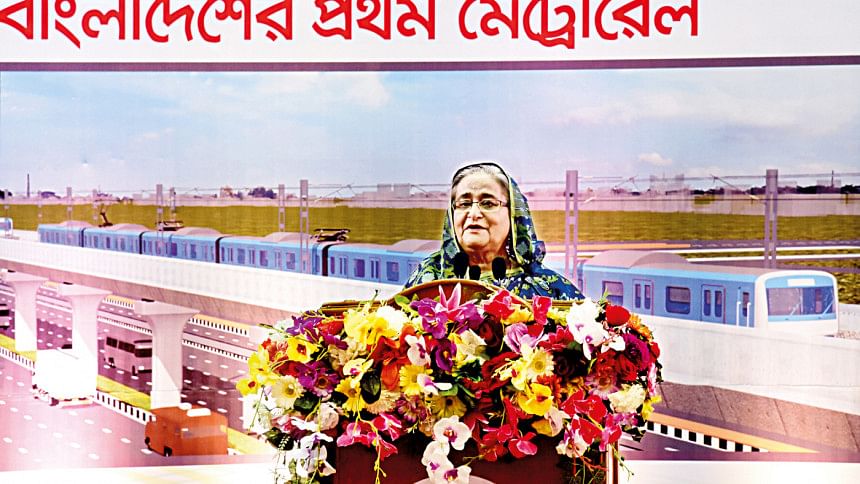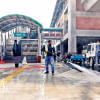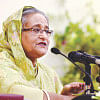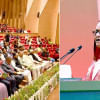MRT Line-6: Twist and turns

The long-awaited metro rail project is finally becoming a reality as the country's first overhead electric train will be launched today, bringing with it excitement and also its share of challenges. Since its inception in 2012, the Mass Rapid Transit Line 6 (MRT Line 6) between Uttara and Kamalapur has faced various obstacles that have slowed its progress over the past 10 years.
Frequent changes in the design of the MRT Line 6 route were the main challenges for the initiation of the project. In addition, the Holey Artisan incident and the COVID-19 pandemic also presented major challenges that the authorities had to overcome to implement the Tk 33,472 crore project. The city dwellers, who have watched the construction of the massive structure day after day, are now ready to take the new mode of transportation in the country.
However, the journey of the highly technical project was not easy at all. Hundreds of experts and engineers, many of them from foreign countries, worked tirelessly using state-of-the-art technology to make the dream project a reality.
The project was first conceptualized in the Strategic Transport Plan (STP) for Dhaka city, which was approved in 2005 and took seven years to formally start in 2012. According to the STP, three BRT (BRT-1,2,3) and three MRT (MRT-4,5,6) lines were proposed for Dhaka city. The route for MRT Line 6, as per the STP, was supposed to start from Pallabi and then go through Mirpur (Begum Rokeya Sarani), Tejgaon, Karwan Bazar (Airport Road), Hatirpool, Nilkhet (Sonargaon Road), Palashi (Zahir Raihan Sarani), Phulbaria, and Syedabad.
The Japan International Cooperation Agency (JICA) conducted the Dhaka Urban Transportation Network Development Study (DHUTS) in 2009-10 to conceptualize basic urban development scenarios for Dhaka city up to 2025 and to select priority projects. The study selected MRT Line 6 as a priority project but suggested modifying its alignment.It proposed extending the line up to Uttara from Pallabi and diverting the line towards Shahbagh, TSC, Central Shaheed Minar, Dhaka Medical College gate, Phulbaria, and Syedabad.
However, the construction of the Hanif Flyover by the Dhaka City Corporation emerged as the main obstruction for the route, and JICA, which was negotiating with the government for financing the project, declined to move forward with the plan, according to experts and officials.
The authorities then came up with a new alignment by diverting the route towards Curzon Hall from the TSC of Dhaka University towards the Jatiya Press Club and Bangladesh Bank. JICA agreed with the new alignment. Later, the authorities, following the prime minister's directive, took the initiative to extend the line up to the Kamalapur Railway Station.
Interestingly, there were more issues with the route alignment. According to the original route plan, the metro rail line was supposed to run through Bijoy Sarani, but the Bangladesh Air Force objected to the route on Bijoy Sarani, arguing that it would be an obstruction to aviation-related operations from the Tejgaon airfield nearby during emergencies.

Later, the authorities realigned the metro line through the Khamarbari side of the parliament premises. In addition to the route, the authorities faced a similar problem in selecting a location for the metro rail depot. After two attempts, they were able to select Diabari as the depot.
Although the project was approved in December 2012, its physical works could not commence before mid-2016 as the authorities had to complete detailed design and other preparatory works. Prime Minister Sheikh Hasina finally inaugurated the construction work of MRT Line 6 on June 26, 2016. However, the project received a severe blow within a week after the Holey Artisan Café attack in Dhaka on July 1, in which seven Japanese, among others, were killed.
The works on MRT Line 6 halted after the attack, although the deceased Japanese engineers and consultants were involved with the feasibility study of MRT Line 1 and MRT Line 5 (Northern route). "During the implementation, we faced two very important incidents. One is the 2016 Holey Artisan incident that tragically killed seven Japanese… It was quite a difficult time," said Ichiguchi Tomohide, chief representative of JICA Bangladesh Office, describing two major challenges in the project implementation process.
"Thanks to the DMTCL [Dhaka Mass Transit Company Ltd—the implementing agency of the project] and other government ministries, special safety arrangements were made to build confidence among the Japanese and other companies, who were afraid of coming to Bangladesh. Then, the foreign companies took part in the bidding process," he told The Daily Star recently.
After the initial setback, the fast-track project, which was being implemented in eight packages, gained momentum. However, physical work came to a halt again when the government imposed a shutdown in March 2020 to contain the spread of the coronavirus. The project saw only 0.55% progress in April and May that year. Many foreigners, especially Japanese, were unable to return to Bangladesh for work, severely hampering progress.
"Many people had gone back to the country. But thanks to DMTCL efforts, after a few months, better measures were taken and the people again came back and resumed work," Tomohide said. In an effort to build confidence in engineers and workers, the metro rail project authorities took many steps, including setting up two field hospitals for their employees infected with Covid-19.
In addition to these challenges, managing traffic during construction was a major concern for the project authorities. As a result, much of the work was done at night, with certain sections of busy roads, particularly in Mirpur, being blocked off. Today (December 28), a 12-km stretch from Uttara to Agargaon will be inaugurated. It will take approximately 10 minutes to travel this stretch, and the cost will be Tk 60. The Uttara-Agargaon route is part of the 20.10 km route to Kamalapur.
Upon completion of the MRT lines in June 2025, it is expected that a passenger will be able to reach Kamalapur from Uttara in around 40 minutes, a journey that currently takes more than two hours by bus. The Agargaon to Motijheel section is expected to be operational by December of next year.
There will be 17 stations between Uttara and Motijheel, and it is projected that around 4.83 lakh people will be able to commute daily between Uttara and Kamalapur in 2025.
The MRT-6 line will connect six important areas of the city: Kamalapur, which is home to the country's largest railway station; Motijheel, the commercial hub of the capital; Dhaka University, the premier public university; Farmgate, the apparent center of the city; Mirpur, one of the biggest neighborhoods in the city; and Uttara, which has become a major neighborhood.
"There were many challenges to overcome, including selecting land for the depot, changing the route alignment, and dealing with the pandemic. Despite these challenges, the metro rail is now ready to roll out," said Anisur Rahman, a joint secretary of the Road Transport and Highway Division who is responsible for MRT issues.
"The metro rail is no longer a dream, it's a reality," he added.



 For all latest news, follow The Daily Star's Google News channel.
For all latest news, follow The Daily Star's Google News channel. 







Comments